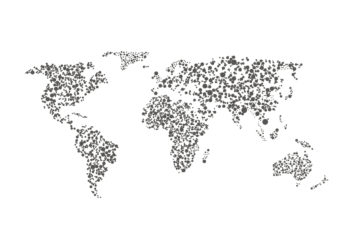Last week, I co-facilitated a workshop on the topic of diversity at the Researcher to Reader conference in London. I have to confess, I was a little reluctant to do it at first, but I’m very glad that I did.

An unmet need
Last year, I put a lot of thought into how actively I want to, or should engage in discussions on diversity. On the one hand, the irony of writing posts and co-organizing workshops about diversity as a person of my particular demographic status does not escape me, despite this post’s rather facetious title. As the response to the previous ‘Ask the Chefs’ post on diversity shows, if a group talking about diversity, no matter how well-meaning, aren’t diverse themselves, then we run the risk of appearing self-serving.
On the other hand, why should it fall on the shoulders of the underrepresented to ensure that their voices are heard and their persons are respected? Especially when, as my colleague Betsy Donohue explained in her recent post, finding your voice is much harder for members of some groups than for others. If the Kitchen and the Chefs do have a leadership role in the publishing community (a concept which makes more than one of us slightly uncomfortable), then we do have a moral obligation to wield that privilege for the betterment of our community. This is especially true if we can increase the diversity of people who have a voice by doing so.
Last year, when I was planning the STM association Future of Publishing seminar, I bit the bullet and put together a panel on diversity and resilience in scholarly publishing. I didn’t want to put it at the end of the program because I didn’t want it seen as an after-thought, so I placed it up front as the keynote panel. At the time, it felt like a gamble, but the shift in attitudes towards the LGBT community over the last decade, what seems like a very recent willingness for society to think and talk about issues around gender identity, and of course #metoo, it seemed like there was a window of opportunity to make real progress on diversity.
Boy, was I right about that! For the panel, I recruited Nancy Roberts of Business Inclusivity, who became my co-organizer for the R2R workshop, to explain how she works with businesses to help them become more diverse. My colleague from Holtzbrinck, Isabel Thompson then explained why it makes business sense to be diverse. Between the two talks, they showed how diversity leads to differing perspectives, which lead to more options, and to better decision making. The result is a greater ability to adapt to a changing market. Finally, Michiel Kolman told the story of Elsevier Pride and how Elsevier fosters inclusion by making sure that everybody feels welcome.
The story that we told was great. I was expecting it to be. What surprised me was the audience reaction. Without setting out deliberately to do so, we managed to create a safe space in that meeting room and people started talking. There was legitimate anger that needed a place to be expressed and validated, and empathy for those who felt excluded. In the break that followed, a person that I know in their role as a customer confided in me how he used to feel anxious when mentioning his husband to people for the first time. Even then, I noticed him pause slightly before the word ‘husband’ and break eye contact.
It is not acceptable that people are conditioned to feel that way and something has to be done.
Safe spaces get a bad rap
The concept of the safe space has a somewhat mixed reputation. Notable, certain white, middle-aged, British comedians seem to have an objection to them, see Stephen Fry and John Cleese. To be fair, there is an argument here about the limits of free speech and the ability to engage effectively with and refute opinions that you find personally offensive. After all, if we can’t bear to argue, we’ll never learn the rhetorical skills necessary to move opinions forward. Judith Shulevitz ably deconstructed these arguments and distinguished between enforced and mutually agreed safe spaces in this 2015 New York Times article.
It’s the mutually-agreed safe spaces that we need for this type of discussion. A place where people can’t be discriminatory but can discuss how discrimination happens without fear of being ostracized for saying the wrong thing. As Patrycja Przybylak, Managing Director of LGBT professional membership organization Out-Standing said to me during a research call before the workshop Many people are afraid to engage in this conversation because they’re scared of making a mistake. This rings true to me. I’ve spoken to more than one straight, white, middle-aged man who steers clear of this discussion out of a fear they’ll make an unintended blunder, or be misinterpreted.
This fear may be unwarranted, but there are good people who could contribute to the conversation in meaningful ways that are currently absenting themselves. So in my mind, this goes both ways. We need to reassure people of all demographics that they are welcome both in the workplace and in this conversation.
It was that sense that I wanted us to recreate last week in the workshop. I think we did a pretty good job. We managed to create an atmosphere where people were comfortable discussing what they’ve learned in their personal experiences and were learning in the workshop.
Using personas to understand our the biases inherent in scholarly communication
Nancy started the workshop off with an empathy exercise to help us think about the times when each of us has felt excluded, and to give us a sense of just how often many people feel disadvantaged, voiceless, or uncomfortable. Having set the tone, we moved onto a series of exercises over the three one-hour sessions that included personas of underrepresented groups and journey maps that exposed barriers to entry and advancement.
We wrapped the last session up with a series of key points that we’re planning to make the basis of a document; a manifesto, if you will, that a few of the workshop attendees have agreed to co-author.
In the next post on this, Nancy will explore what we did in greater depth and report on some of the things that we learned. She’ll write about how many communities simply haven’t heard of what we do and have no way of finding out. No matter how talented they may be, we’re not going to meet those people unless we find ways to reach out. She’ll also explain how privilege, or the lack of it, affects how people are valued, how much they’re paid and whether they advance in their careers. These effects are often not related to how much value an individual can provide to a business, and so it is in our collective interests to reach out to people, to champion them and to support their development.
Discussion
20 Thoughts on "Towards a Diversity Manifesto Part 1 – How a White, Middle-aged, Straight, Cisgender Man Co-organized a Workshop on Diversity Without an Apparent Shred of Irony."
Thanks Phill, awesome post, and so good to see you and others taking the lead here, and to bring forward different perspectives … it can feel awkward at times talking about some issues and experiences, especially for fear of being judged or a comment being misinterpreted … the safe space makes total sense … and it’s good to continue to raise a wider awareness and plan effective next steps.
It was a very good workshop, Phill. While part of the learning experience in it was hearing other peoples’ stories, the approach you and Nancy took was action-oriented.
Even those who are members of groups that are underrepresented in one aspect of our identities might be privileged (or just lucky) in another aspect. And I feel we can use the one as a lever of sorts in the other. So perhaps with privilege there are responsibilities to make it better for the next generation.
In the sub-group that I participated in, we had the challenge of outreach for entry-level positions to people who are not likely to have even heard of scholarly publishing. Yet those people will likely be the ones who give new strength to the industry because they know things (and skills) we don’t know. So right after our workshop, I went into an AT&T cell phone store and was listening and watching how the reps interacted with customers to spot people who had a talent or style that would transport to our industry. They didn’t just know their products, but they knew how to learn what a customer needed and whether they had that.
Hi John,
Thanks for your kind words about the workshop.
I think your subgroup had the most challenging but interesting persona to think about. As you identified, the ways in which we attract talent to our industry now relies on access to a fairly narrow cross section of people. There is talent everywhere, and we need to find ways.
I really like your exercise of going to a place of business and just observing how many talented and motivated people are out there. The next step is thinking about how to reach out and make these people aware of our existence and find ways to bring them in.
Maybe that’s putting job adverts on public transport or having publishing apprenticeships that pay for people’s college education while working.
Firstly, I wholly agree with Isabel Thompson’s sentiments that there is a business advantage to diversity. As a POC, and specifically a British Indian man, working in an editorial role in the UK, I very much feel under-represented within UK scholarly publishing (although I benefit from other privledges). I often feel that POC in the UK are under-represented in customer facing roles e.g. Editorial, Marketing, Sales. One of the things that have made me hesitant in the past about raising this or being engaged in panels like this are conversations I’ve had with colleagues that are surprised by my feeling of under-representation; which often falls into an exchange of anecdotal evidence (on both sides). So talking to them about the missed business opportunity of diversity appears to fall on deaf ears. It seems to me one of the challenges of talking about under-representation is really knowing what communities/experiences are under-represented and in what regard? Is that handled in the manifesto somehow?
Thanks Nikul.
That’s a fantastic point. People do often act surprised when the subject of underrepresentation comes up. That may partly be due to people’s discomfort with accepting that unconscious bias is at work.
I’m not sure what the manifesto will eventually contain, but certainly the idea of better understanding what we mean by underrepresented would be helpful. If you’d like to get involved in the manifesto, I can put you in touch with some of the people who are taking the lead on authorship.
Thanks Phill, that would be great. I’ve emailed you seperately.
I appreciate this post as it expands on the conversations across many organizations within scholarly publishing – moving beyond intent to action / engagement. It also brings clarity to some of the language – mutually agreed safe space. While I find real snowflakes magical with their unique structures, I cringe when I hear it used in the media as a way to dismiss others. I’ll agree that there is value in strength but we all benefit by creating environments where everyone can express their ideas and perspectives without being devalued for them. Cultural shift involves change for all of us and your workshop is an example of how we can participate in the process.
Great post, thank you Phill. Creating safe spaces to discuss the often difficult issues around diversity and inclusion is exactly what is needed – including here on the Kitchen. I have a lot of sympathy with those who “are afraid to engage in this conversation because they’re scared of making a mistake” – I suspect that many of us feel that way at times. But while we should be able to speak out when we have something to say, including when we see or experience bias in action, we should remember that active listening is an important form of engagement too – one that everyone can participate in.
Thanks for this post Phill – and plaudits for the workshops. I’m sorry I wasn’t able to get to R2R this year so missed it. With respect to the issue your title raises, it is absolutely the case that under-represented minorities need the support of those in the majority – we need allies. As you said “why should it fall on the shoulders of the underrepresented to ensure that their voices are heard?”. The concept of allies is an important one – we want to ensure inclusion not just diversity.
I could not agree more.
A while ago an academic that I know attended stonewall diversity training. During that event, the point was made that it’s not enough to simply say that you don’t discriminate when the subject comes up or even to hire more people from underrepresented demographics. There is a need to pro-actively make people feel welcomed and valued during the hiring, onboarding and career development process. The reason is that if people have often felt unwelcome in the past, they will assume that they’re not welcome until it’s proved otherwise.
In the days after, this particular academic put a rainbow flag up in their lab break room. A couple of days later, one of their grad students who had suffered a history of bullying came out to them in what the student intended to be a casual exhange. It was during the same conversation that this talented young person asked if they could stay in the researcher’s lab for their post-doc. Given how effective and smart the student was, the academic was delighted.
This might sound at first hearing like a simple story of two people connecting, but in addition to that, it’s an example of active talent retention through effective HR practices.
Thanks for this post, Phill! This sounds like a great workshop to participate in. I’ve just finished listening to Sara Wachter-Boettcher’s book TECHNICALLY WRONG, whose discussion has not a little overlap with (what I’m gathering was discussed during) these sessions, but focused on that semi-nebulous, many-tentacled creature known as the tech industry. One point she makes that I think is equally relevant to scholcomms is that the pipeline is an issue but not *the* issue; another and (at least in tech) bigger issue is being able to attract people from underrepresented groups, but then driving them out by way of harrassment, refusal to hear what they have to say, etc., and finally — to finish out the vicious cycle — concluding that, oh well, “they weren’t a good fit”.
Lots to think about!
In case you missed it, we had a review of that book here:
https://scholarlykitchen.sspnet.org/2018/01/11/book-review-technically-wrong-sara-wachter-boettcher/
I had indeed somehow missed that, but having now read it, I found it amazingly concordant with my own impressions of the book…
I think one danger we need to worry about in this context and others is the spistemic bias urged by some that declares that, unless you are a member of a minoity group and have directly experienced discrimination, you cannot understand what it is or means. A commentator recently aclled this “the tyranny of the subjective”: http://quillette.com/2018/03/19/the-tyranny-of-the-subjective/ It privileges subjective narrative over anything else as a path to the truth. In a publishing context, this view would hold that only a female editor can properly be a judge of the merits of studies about women, only a black editor could oversee a series about the African American experience, etc. While not denying at all the advantages of lived experience as an aid to understanding, this view when pushed as an ideology undermines and interferes with the search for truth. This stance may partially explain why sometimes white males are reluctant to get engaged in discussions of this sort.
Thanks Sandy for that interesting perspective.
Having written this article and experienced the reaction to it in the comments, social media and privately, I think that I can offer some comfort. Everybody who has communicated with me about it has been nothing but supportive and encouraging. Nobody has told me that I don’t have a right to talk about the subject or that I lack the credibility to speak about it. In that light, I think the word ‘tyranny’ is a bit dramatic.
Having said that, as I wrote above, some people are worried about making mistakes and occasionally people do. In the past, I’ve said the wrong thing while trying to be supportive and I know more than one person who’s had a similar experience. My way of de-risking this is to communicate more, not less. The more we talk about things, the more we learn about how our words affect people and the more they learn to trust our intentions. In a more open environment, misunderstandings can be addressed quickly without us either becoming defensive or assuming the worst of one another.
That’s good to know, Phill. Perhaps the reductio ad absurdum of the position I outlined would be to say that you can’t criticize Donald Trump for his misogynistic comments unless you are a white male of his generation (which I am, by the way).
Great and important post, Phill. I’ve found it’s sparked many discussions with people over the last couple of days.
In terms of Resilience, as you mentioned I discussed at STM – we live in a tightly entwined ecosystem, where publishers, academics, institutions, funders, tech platforms, librarians, and start-ups etc all interlink. I believe this has ramifications for how we should think about change broadly in scholarly comms (and I’m in the process of writing a Learned Publishing article to that effect), but it also has implications for diversity and inclusion initiatives:
Many of the diversity issues we see in scholarly communications are found across the ecosystem and in academia. I suspect these power structures and demographic tendencies are mutually reinforcing across the ecosystem, and may feed perceptions of how appealing any of these businesses are to work in for any particular demographic. Equally, and more positively, this means that improvements in one area will likely help support improvements across the others, so the implications and importance of working towards these changes are even more extreme! Additionally, since these different groups are all struggling with similar issues, perhaps there are opportunities for e.g. publishers to learn from e.g. universities or tech companies who have undertaken diversity and inclusion initiatives?
Another thought that has occurred to me is that inclusion and exclusion come from the Latin (sorry!) and mean, respectively, to ‘shut in’ or to ‘shut out’. To my mind this implies (metaphorically) an almost physical barrier that requires either the ‘excluded’ group to batter down the figurative ‘wall’, or the ‘included’ group to take it down, unlock the door, or reach out. As you so rightly say, why should it fall on the shoulders of the underrepresented to make their voices heard – it’s much easier to unlock a door than batter down it down from the outside. I see this post, and hopefully as many related initiatives and actions as possible, as an important facet of reaching out.
On that note, and as I imagine Phill is hinting at, I’m interested in the opportunities that immediately exist for everyone to support inclusion in whatever ways are open to them. One of the most obvious examples is conference panels, which strike me as a good example where a bit of extra effort on behalf of what is essentially an ‘in’ group (in any particular subject matter) can make a difference to what are, at least, public perceptions. Conference panel organisers have a direct and obvious way of controlling which ‘voices’ are heard and, in fact, ‘seen’. The focus on gender diversity on conference panels over the last few years has clearly had an impact and improved the gender balance (and I count myself a direct beneficiary), but there is a lot more to be done to seek out speakers that represent a more diverse diversity!
I am hyper-aware that I would never have been speaking at that STM session if someone a couple of years previously hadn’t believed in me, taken a risk, and asked me to chair a session at ALPSP. I had absolutely no experience, but someone let me in, and I am forever grateful. I know that this has since drastically impacted my career – and so while conference panels are only one tiny aspect of addressing any diversity issues, and may only affect a few people initially, they are one of the easiest to do something about. There are a lot of other things we can do, and I am keen to help in anyway I can.
Apologies for the lengthy comment – it’s a big area. (And I didn’t even touch on the business imperative!)
Thanks Isabel,
I think you’re right. It all seems very ingrained because bias and exclusion lead to more bias and exclusion. There’s a self-fulfilling prophecy component to this, as the bar is either willfully or unconsciously placed higher for those that are outside of the dominant demographic. It’s almost a cliche that people are ‘given a chance’ who might not be the sort of person that would normally be hired, but more is expected from them because they’re being ‘given a chance’. When they feel singled out and unwelcome, those in power distance themselves by saying the person was ‘not a good fit’.
As you say, if we chip away at these biases and inequities in one place, it will interrupt that reinforcement in other places. In time, we can hopefully arrive at a place where people are judged more equally irrespective of background or identity.
Hey Phill,
Yes, that’s very interesting and very true. Reminds me of this article, have you read it? http://freakonomics.com/podcast/glass-cliff/ It’s really thought-provoking – pulls together some research picking up on exactly the type of stuff you’re saying. The focus is on female CEOs, but it also says that these situations apply to candidates from minority ethnic and other backgrounds too. I would also imagine that aspects of these issues apply at all hiring levels in some form.
It says e.g. that Female CEO’s are much more likely to be hired when a firm’s in trouble; to be targeted by activist investors; to have differing expectations etc etc. Not all negative – it also says for example that firms often look for stereotypically ‘female’ qualities when a firm is struggling – but in general there’s a strong suggestion that female and minority candidates can often be almost set up to fail, and that if/when they do (due to sub-optimal conditions and biases), this just reinforces any conscious or sub-conscious prejudices. Worth the read.
Isabel
And as a total coincidence, but following on from the interrelations across the ecosystem – I’ve just come across a study that suggests that ethnic diversity may increase scientific impact (well, citations): https://physicsworld.com/a/ethnic-diversity-boosts-scientific-impact/ – pre-print at https://arxiv.org/pdf/1803.02282.pdf. (Some limitations, but interesting!)



